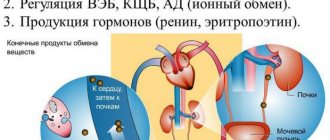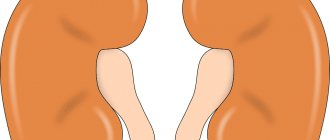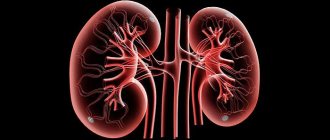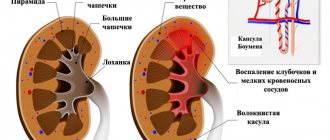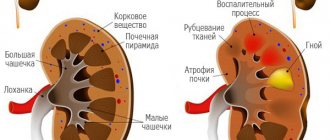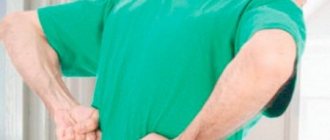Kidney pain is perhaps the most unpleasant symptom of pyelonephritis, glomerulonephritis and other diseases of the urinary system. Analgesics and antispasmodics, which are available in abundance in pharmacies, can help get rid of aching, pulling or cramping sensations in the lower back. And what painkiller do doctors recommend taking for pain in the kidneys? Let’s try to figure it out.
Drugs that can relieve pain
There are no specific drugs to eliminate pain specifically in the kidney area. A wide range of medications – NSAIDs, simple analgesics or antispasmodics – can relieve a patient’s unpleasant symptoms. In the acute stage of the disease, medicine for pain in the lower back and kidneys is usually prescribed in injections; when the condition stabilizes, you can continue to take pills.
The main indications for prescribing painkillers are:
- acute and chronic (in the acute stage) pyelonephritis - inflammation of the collecting apparatus;
- acute and chronic glomerulonephritis - inflammatory damage to the glomeruli of the kidneys;
- pain syndrome in acute renal failure;
- urolithiasis, urolithiasis;
- hydronephrosis;
- polycystic kidney disease.
Since the pathogenesis of the development of pain in kidney pathology is associated with inflammatory damage to the tissues of the collecting apparatus or parenchyma, a good effect is observed when using drugs from the NSAID group.
NSAIDs, or non-steroidal anti-inflammatory drugs, are a broad pharmacological group, the main effect of which is to reduce inflammation by reducing the release of prostaglandin, interleukins and other biologically active substances by cells. Due to this, damage by the immune system to the kidney tissue stops, and redness, swelling, functional impairment of the organ and pain disappear.
Which anti-inflammatory tablets are good for relieving kidney pain? Most often, doctors prescribe to their patients:
Ibuprofen (trade names - Dolgit, Ibufen, Nurofen) A drug based on propionic acid. It has antipyretic and slightly less pronounced anti-inflammatory and analgesic effects. It has several convenient forms of release - tablets, injections, suspension for children, rectal suppositories. May have an irritating effect on the gastric mucosa, so it is not recommended for gastritis and peptic ulcers. The drug has an affordable price - 20-70 rubles. for 20 tablets with a dosage of 200 mg. Ketoprofen (trade names - Ketonal, Flamax, Fastum) Another propionic acid derivative, which is distinguished by its high efficiency and speed of action - the pain goes away within 12-15 minutes after taking the tablet. Can be used by injection (in the acute stage of the disease), orally and externally on the kidney area (in the form of a gel). Ketorolac (Ketorol) Another medicine from the NSAID group, which is prescribed when the kidneys hurt. It is distinguished by a good analgesic effect and an affordable price within 50 rubles. for 10 tablets. Indomethacin Refers to derivatives of acetic acid. In addition to anti-inflammatory and analgesic, it has a pronounced anti-edematous effect. Available in the form of tablets, injection solution, ointment (gel) for external use. Nimesulide (Nise) Another representative of NSAIDs with a good analgesic effect. The drug negatively affects fertility, therefore it is strictly prohibited for pregnant and nursing mothers, as well as women planning pregnancy in the coming months.
Note! According to recent data, patients with chronic kidney disease are not recommended to manage pain exclusively with NSAIDs. Long-term use of these drugs may increase kidney damage. Patients who take anti-inflammatory pills for 30 days increase the risk of developing kidney failure in the next 5 years.
Analgesics
Simple analgesics are a special pharmacological group that has analgesic and antipyretic effects. The most popular medications for kidney diseases are those based on metamizole sodium:
The mechanism of action of these drugs is based on suppressing the synthesis of prostaglandins - mediators of inflammation and hypersensitivity reactions. The development of the medicinal effect of such drugs occurs quickly, and the pain subsides 10-15 minutes after administration.
Analgesics, like NSAIDs, are not suitable for long-term treatment. They can lead to diseases of the blood system - agranulocytosis. Therefore, in the USA and many European countries, Analgin and its analogues are considered potentially hazardous to health and have been discontinued.
Antispasmodics
Antispasmodics are a separate group of drugs that are recommended to eliminate pain in acute and chronic kidney diseases. Their mechanism of action is based on relaxation of the smooth muscles of the collecting system and urinary tract, which are in a spasmodic state with pyelonephritis, cystitis, urolithiasis or UTI. This not only reduces pain, but also eases the impaired flow of urine, which promotes a speedy recovery.
Popular antispasmodics are:
No-shpa A product based on drotaverine. It has a pronounced relaxing effect on smooth muscles and is prescribed as part of complex therapy for nephrolithiasis, pyelitis, pyelonephritis, cystitis, and bladder spasms. Available in the form of tablets and solution for injection. Average price – 200 rub. for 40 tablets. Papaverine A medicine with the same active ingredient. Usually prescribed as an antispasmodic and vasodilator for renal colic. It has several convenient release forms - tablets, solution for intravenous and intramuscular administration, rectal suppositories.
Painkillers for renal colic: injections, analgesics, antispasmodics
In case of acute pain and the impossibility of hospitalization, an intramuscular injection is necessary. The pharmacology of painkillers shows that the most effective in these cases are: No-shpa, Spazmalgon, Papaverine or Analgin with Diphenhydramine. You can also use Baralgin.
It must be remembered that painkilling injections will not get rid of the cause of the pain. The patient, one way or another, needs the help of a specialist. The patient will be prescribed antibiotics. In addition, treatment includes taking Pentoxifylline. This will improve blood circulation. The doctor may also prescribe medications for inflammation.
For effective treatment, non-steroidal anti-inflammatory drugs are prescribed. Their main advantage is to reduce the rate of prostaglandin synthesis, as well as reduce urine formation and reduce renal blood flow.
The first drug is used intramuscularly, orally, as well as sublingually and rectally. To eliminate an acute attack of pain, an intramuscular injection of 75 mg of the drug 1-2 times a day is necessary. The use of Ortofen continues orally.
A good drug is a combination of Diclofenac and Misoprostol. A similar composition is called Arthrotek.
The drug that is inferior in strength to Arthrotek is Ibuprofen. It is better tolerated by the body and is the least toxic among all NSAID drugs. The reaction occurs a maximum of five hours after taking the drug orally.
The next drug is Indomethacin. One of the most active medications in terms of anti-inflammatory effects on renal colic. It also has a strong analgesic effect. Within 15–20 minutes after taking the drug orally, diuresis decreases by 50%.
According to statistics, 22% of patients who received an injection of Indomethacin developed a need for narcotic analgesics. 11% of those taking Diclofenac needed analgesics.
Ketorol (or Ketorolac) is known for its effectiveness in the fight against pain, as well as the treatment of renal colic. It is often used to anesthetize one or another organ of the human body after surgery or before serious procedures.
It has the ability to be quickly absorbed into the body. The analgesic effect occurs within ten minutes after the patient drinks the medicine. The main principle of action of the drug is inhibition of the interaction of prostaglandins.
The drug does not interact with opiate receptors.
Its effectiveness in pain relief is comparable to that of Diclofenac and is often used for renal colic. The daily intake should not exceed the norm of 40 mg, and it is not recommended to take Ketorol for more than seven days.
Analgin (also called Metamizol or Baralgin M) is the most common painkiller in Russian medicine.
It is often drunk to relieve renal colic. This drug is an effective analgesic with an antispasmodic effect.
The combination of Metamizole with two antispasmodics (with myotropic and atropine-like effects) is used to reduce the pain effect caused by spasms.
If the patient has chronic gastrointestinal diseases, then antispasmodics and antidiuretics are used to combat renal colic.
Signs of kidney pain
Everyone knows that the kidneys are located in the lumbar region, and often regard any discomfort in the lower back and above the pelvis as pain in the kidneys.
In fact, the pain is localized a little higher - closer to the ribs, since the kidneys are located in the upper half of the lower back.
As for the nature of the pain, in most diseases they can be constant or periodic, more often mild, nagging, aching, accompanied by fever, weakness and other signs of inflammation.
It is not easy for a person who is experiencing kidney pain for the first time to independently identify them, because there are other organs nearby that can also give discomfort in the same area: the liver, spleen, appendix, spine.
Antispasmodics
Antispasmodics are tablets for kidney pain that are used to relieve spasms in the muscle tissues of the vascular system and internal organs, which leads to a decrease in the severity of pain.
Myotropic antispasmodic medications lead to a change in the ionic balance in the kidney cells, which promotes rapid and effective action. In addition, this group of drugs has a vasodilating effect.
No-Shpa is a representative of antispasmodics, which can be used alone or in combination with other analgesics or antispasmodics. The daily dosage should not exceed 6 tablets. Use is strictly contraindicated if the kidneys hurt due to renal failure. For children, the drug is prescribed only by a specialist.
Drotaverine is an antispasmodic agent that enhances the transport ability of blood and improves the supply of oxygen to cellular structures. Can be used in children over 2 years of age with a daily dosage of no more than 1 tablet, while adults require 3 to 6 tablets to achieve a lasting effect.
Papaverine - a drug with the active substance papaverine has a pronounced antispasmodic effect and is used for colic in the kidney. Ease of use for different severity of pain and for different age groups of patients is ensured by a variety of release forms: injections for intravenous and intramuscular administration, rectal suppositories, tablets.
Antispasmodics
Acute pain in the kidneys is often caused by stones migrating or stuck in the ureter and problems with urinary drainage. To relieve this condition, it is necessary to ensure the expansion of the lumen of the urinary ducts to facilitate the passage of the stone into the bladder.
These are myotropic antispasmodics based on drotaverine, used for spasms of the urinary tract. They help relieve pain in the kidneys, but in conditions of renal colic they are less effective.
Read about the features of treating pyelonephritis with antibiotics on this page.
And here https://mkb2.ru/klinicheskie-proyavleniya/onkourologiya/lechenie-kistyi-pochki-narodnyimi-sredstvami.html is all about traditional methods of treating cysts. Find out how beneficial herbal tea can be and what the principles of proper nutrition are for such diseases.
- Spasmalgon;
- Spazgan;
- Spasmonet;
- Baralgin;
- Took;
- Revalgin;
- Baralgetas;
- other analogues.
These medications are administered intramuscularly or orally, 1-2 tablets per dose.
Classification of antispasmodic drugs
All drugs whose action is aimed at relieving spasms are classified according to the mechanism of action on the human body. The following are distinguished:
- Myotropic drugs. Directly affect the structure of the smooth muscles of the body, changing all the biochemical processes occurring in them. Such antispasmodics are produced on the basis of drotaverine hydrochloride. This group of drugs includes No-shpu, Mebeverine, Drotaverine, Otilonium bromide, Bendazole, Papaverine, Bencyclane, Gimecromon, etc.
- Neurotropic drugs. Here the medicine acts on impulses in the nerve endings that stimulate the smooth muscles of the organ oppressed by pain. These drugs are based on M-anticholinergic drugs. This group of antispasmodics includes Bucospan, Arpenal, Metocinium, Aprofen, Difacil, Ganglefen, etc.
In addition, all antispasmodic drugs can be classified by type of origin. There are artificial remedies and natural antispasmodics. The latter include belladonna, chamomile, marsh calamus, lily of the valley, tansy, mint, oregano, etc.
In addition, all drugs with antispasmodic action are distinguished by form. There are these:
- Tablets and dragees;
- Rectal suppositories;
- Tinctures;
- Granules for preparing a suspension or solution;
- Injection ampoules.
Analgesics
If pain occurs, the most logical solution is to take a pain reliever. What pills help “for kidney pain”? Drugs sold freely in pharmacies are divided into 2 groups:
- Antipyretics are simple analgesics based on analgin and paracetamol. These include such popular drugs as Analgin, Pentalgin, Tempalgin, Baralgin, Nurofen, Efferalgan, Panadol. These medications have an analgesic effect and reduce fever.
- NSAIDs are nonsteroidal anti-inflammatory drugs that, in addition to analgesic and antipyretic effects, reduce the severity of inflammation. This group includes Aspirin, Diclofenac, Indomethacin, Citramon, Askofen and others.
Only in cases of excruciating, unbearable pain can the attending physician authorize the administration of narcotic analgesics.
And in this section there is detailed information about the treatment of pyelonephritis at home. How to achieve a therapeutic effect when taking herbs and medications?
Analgesics of the opiate group include Morphine, Fentanyl, Promedol, codeine. These kidney pain medications can be purchased with a special prescription or received in an inpatient setting.
The most effective medicines
When your kidney hurts, you urgently need to take an effective remedy that will get rid of the pain. When you come to the pharmacy and indicate the name of the drug you are looking for, you should make sure that this drug is supplied to the pharmacy chain for free sale and a prescription is not required.
Among the drugs that are highly effective and used to relieve pain in renal colic or eliminate manifestations of the inflammatory process, the following are especially popular:
- Analgesics. Treatment with painkillers is carried out under the supervision of a doctor. To achieve a positive result, you can use Analgin and Pentalgin, Tempalgin and Nurofen. Take these tablets no more than three times a day, keeping the same amount of time between doses.
- Antipyretics are tablets made from herbal ingredients that reduce body temperature and have an analgesic effect. By using such medications, you can relieve your child of pain, since these drug therapies include natural ingredients.
- Treatment with non-steroidal anti-inflammatory drugs is carried out strictly as prescribed by the doctor. One of the patients who took Diclofenac complained to the nephrologist about stomach pain. After a detailed conversation, the doctor determined that the woman had violated the medication regimen, which provoked the development of gastritis. Drink Indomethacin and Canephron in strict accordance with the prescription and the instructions included with the tablets.
- In the most difficult cases of maximum effect in the treatment of the inflammatory process and to relieve the patient of severe pain in the kidneys, therapeutic measures are carried out using Diclofenac injections. Only medical workers have the right to give injections.
Each drug, without which the treatment process is simply impossible, is selected by the attending physician depending on the individual characteristics of the patient’s body, diagnosed concomitant diseases, age and severity of the underlying illness.
pochki2.ru
Additional Help
If discomfort occurs in the kidney area, you should see a doctor, and if colic occurs, call an ambulance. How to treat pain in this case? Warmth and active “rinsing” of the urinary tract help relieve pain in kidney diseases.
- Place a warm heating pad on the kidney area (from the side of the affected organ), hold for 15-30 minutes. The heat will relax spasms and reduce the intensity of pain.
- Take a hot bath for half an hour. This method of pain relief is contraindicated for patients with cardiovascular pathologies, gynecological and intestinal diseases.
- Drink more fluids (2 liters per day), take diuretics and drinks - pathogens, sand, salts will be washed out of the kidneys with urine, reducing the severity of inflammation and pain.
The principle of action of diuretics
For colic caused by the movement of sand or pebbles, the following procedure is recommended:
- Give an injection or take 2 tablets of a combined antispasmodic.
- Prepare a thermos of hot tea with lemon.
- Place all the necessary things next to you: tablets, phone, book, since you will not be able to get up for several hours.
- Lie on the bed so that your kidneys are above your bladder; if necessary, place a pillow under your back and shoulders.
- Take 2 heating pads or warm water bottles. Clamp one of them between your legs, place the second under the lower back on the area of the sore kidney. Lie as long as you can, drink tea periodically.
- At night, take a Panangin or Asparkam tablet and a Magne B 6 tablet.
- The next day, repeat the procedure if the colic does not stop.
Kidney stones, pain. What to do?
Before the medical professional arrives, the most important thing is to relieve pain. But it is permissible to use all known methods of pain relief only when there is 100% confidence that this is a stone passing. If pain on the right is observed for the first time, then you can take any antispasmodic drug. It will reduce pain without changing the overall picture of the disease. And a medical professional will be able to distinguish pain in the right side from appendicitis or discomfort when a stone passes.
But if the pain is observed on the left side, then the use of antispasmodics can blur the clinical picture inherent in serious diseases (splenic infarction, intestinal obstruction). Back pain indicates serious diseases of the spine: osteochondrosis or herniated disc.
If the diagnosis of “nephrolithiasis” has already been established by a doctor, and this is not the first time that a stone has passed, then the following procedures are recommended:
- applying heat to the affected area (heating pad, blanket, or taking a hot bath);
- taking painkillers or antispasmodics;
- intramuscular or intravenous injections (given by a medical professional) m.
When a stone leaves the kidney, its path always goes through the urinary canal, which causes severe pain. You can provide first aid at home before medical personnel arrive when you are completely confident in the diagnosis.
Folk remedies
Treating kidney pain using traditional methods alone is hardly possible.
But still, the use of recipes with anti-inflammatory and diuretic effects for nephropathologies is recommended even by official medicine.
- When taking a warm bath to alleviate pain, add essential oils (cypress, juniper) and oat straw decoction to the water.
- A fruit drink made from cranberries and juniper fruits fights inflammation and has a soothing effect on irritated mucous membranes. Drink the drink without sugar or with a spoonful of honey.
- Infusions of burdock and dandelion leaves cause increased urine production, which helps “wash out” bacteria and stones from the kidneys.
Kidney pain is often so severe that it is impossible to manage without the use of medications. In what cases should you start taking them and which tablets for kidney pain help best?
Side effects of drugs
Drotaverine and its derivatives can cause a nausea reflex and even vomiting.
Like any other drug, all antispasmodics can have side effects on the human body. Depending on the type of drug, they may be:
- Drotaverine and its derivatives. They can cause a nausea reflex and even vomiting. Also, while taking such antispasmodics, dyspeptic disorders (diarrhea, constipation, flatulence) may appear. Such pain medications can also cause changes in heart rate and a decrease in blood pressure. Difficulty breathing, sleep disturbances, or allergic itching are also possible.
- Meverine may cause angioedema or urticaria.
- Hyoscine and its analogues in some cases provoke dry skin and mucous membranes, disrupt heart rhythm, and can lead to urinary retention and even anaphylactic shock.
- When taking Spazmalgon (especially if I drink uncontrollably), abdominal pain, exacerbation of gastrointestinal problems, nausea and vomiting, as well as headaches, vestibular disorders, malfunctions of the urinary system and even changes in blood composition may occur.
In what situation should you take the pills?
You can take painkillers for pain of varying intensity. There are practically no cases where taking medications may be contraindicated. The only exceptions are critical clinical situations.
An important point is that drugs should be selected exclusively individually. Different medications are prescribed for different diseases. For example, for inflammation in the kidneys, drugs containing aspirin are indicated, which are strictly prohibited for renal colic. There are no universal remedies, remember this.
What are the most common causes of kidney pain?
Kidney pain can be caused by the following problems:
- pathologies of the urinary system. These include pyelonephritis, urolithiasis, glomerulonephritis, various neoplasms, etc.;
- kidney injuries, such as bruising or rupture of kidney tissue;
- damage to other organs. In this case, pain may be felt in the kidneys.
Only an experienced specialist can determine the more precise cause of pain based on the examination and the necessary tests.
What medications should I take for kidney pain?
The patient may be prescribed different medications. Depending on the cause of the pain, the spectrum of action of the drug is determined. All of them are divided into several main groups:
Let's take a closer look at each group.
Myotropic antispasmodics
They are used if pain in the kidneys occurs due to passage or stuck stones. In such situations, problems with urination and pain during this process are observed. The action of antispasmodics is aimed at increasing the lumen of the urinary ducts so that stones can pass out more freely.
The following medications relax smooth muscles well and reduce spasms:
- No-spa is usually taken in combination with other medications. Adults are advised to consume 3 times 2 tablets. The drug is prohibited in case of renal failure.
- Papaverine and Platyphylline act due to drotaverine. Both drugs eliminate muscle spasms and thereby relieve pain and saturate the affected tissues with oxygen. Dosage: children over 2 years old – 0.5 tablets twice a day, adults – 2 tablets three times a day. Cannot be used by pregnant and lactating women. Not effective if the cause of pain is colic.
There are also combined antispasmodic painkillers used for kidney pain. These include:
- Spasmalgon . It contains 3 active ingredients. Disinfects and dilates the urinary ducts. Adults can take 2 tablets 3 times every 24 hours. Doses for children are determined individually.
- Spazgan . Relieves pain and temperature. It is an anti-inflammatory and antiseptic. Doses depend on the patient’s condition, but there are generally accepted standards: a maximum of 3 times a day, 1-2 tablets. It is prescribed to children only in extreme cases.
- Spasmonet . This product has a very pronounced and long-lasting effect. Prescribed for the treatment and prevention of kidney pain. An adult patient can take a maximum of 6 tablets per day. Dosages for children are determined by a pediatrician. It should be taken with extreme caution by pregnant and lactating patients.
- Baralgin . Belongs to a group of painkillers and anti-inflammatory drugs used for kidney pain. Presented in tablet and injection format. The rhythm of treatment with injections is determined by the doctor. An adult can take 6 tablets per day (3 times 2 capsules). Children and pregnant women are not treated with Baralgin.
- I took it . Relieves fever and inflammation. Adults and children over 15 years of age can take 6 tablets per day. The drug is prohibited for renal and liver failure, pregnancy.
- Revalgin . In addition to the antispasmodic effect, it also has an anesthetic effect. Prescribed for treatment only in adult (all except pregnant) patients. Consumed after meals. You can drink 1 tablet twice a day. The course of treatment should not last longer than 3 days; with long-term treatment, negative side effects often appear.
- Baralgetas . This is a complex painkiller; its effectiveness does not depend on the location of the pain. The number and frequency of appointments varies depending on the intensity of the pain. It is important that the interval between doses of the medication is at least 6 hours. Children under 5 years of age should not be treated with this remedy.
When treating with antispasmodic drugs, it is important to observe the dosage and timing of treatment. Excessive consumption can cause side effects, and a long course can lead to addiction to the drug.
Analgesics
Analgesic drugs for kidney pain in the format of tablets and injections are used only for pain relief. They can be of synthetic, semi-synthetic and natural origin. Long-term use or incorrect selection of medication may weaken its effect. Analgesics are divided into 2 large groups:
Antipyretics. These include simple drugs whose active ingredient is paracetamol or analgin. In addition to relieving pain, they also lower the temperature. Here are the most popular antipyretic agents:
- Analgin - drink 3 times a day, 2 tablets; in children, the dosage depends on weight.
- Pentalgin - 1 tablet three times a day, course - up to 5 days, minimum break between doses - 4 hours.
- Tempalgin - you can take a maximum of 3 tablets per 24 hours (preferably after meals), consume up to 5 days.
- Nurofen – average dose – 2 capsules 3 times a day.
- Panadol - up to 8 tablets per day with a 4-hour break between doses.
- Efferalgan – 4 tablets 3 times a day, before consumption they need to be dissolved a little in warm water. Take a break between uses. You can drink it for a maximum of 3 days.
Use in childhood
In addition to pregnancy, the following groups of patients should also be careful with antispasmodics:
- People with Crohn's disease and microbial intestinal diseases;
- Patients with tuberculosis;
- Persons with colitis;
- Patients with an enlarged small intestine;
- Patients who have an individual intolerance to one of the components of the selected medication.
Drotaverine requires special attention. It should not be taken by patients with atherosclerosis, glaucoma, prostate hyperplasia, renal or liver failure, heart failure and hypertension. Cardiogenic shock and atrioventricular block of the II-III degree are also a serious contraindication to taking Drotaverine for renal colic and other painful conditions.
Papaverine should be taken with caution in case of traumatic brain injury, hypothyroidism, renal and liver failure, prostate hypertrophy, taicardia, shock. Also, elderly and weak people should not experiment with Papaverine.
The drug is indicated for diseases of the urinary system, including:
- Acute renal colic;
- ICD (nephrolithiasis);
- Pyelitakh, jade;
- Tenesmus of the bladder;
- Pylorospasm, etc.
For renal colic
Renal colic occurs in different cases - both when a stone moves against the background of urolithiasis, and with inflammatory pathologies of the kidneys. It is a sharp pain in the kidney area (one, rarely two), spreading to the lower back, accompanied by increased pressure, nausea, vomiting (not always). No-spa as a powerful antispasmodic is used when the kidneys hurt due to renal colic to quickly eliminate the spasm and to minimize pain.
Due to the high risk of surgical pathology, it is undesirable to relieve such pain without calling a doctor - taking pills is only a temporary measure until the ambulance arrives. It is acceptable to take Baralgin or No-shpa. Dosage - 80 mg - 2 tablets (maximum single dose). In a hospital setting, a patient with renal colic is usually administered the drug intravenously in a volume of 40-80 mg.
For stones and sand in the kidneys
The antispasmodic properties of the drug allow it to be used for acute and chronic forms of urolithiasis, that is, during acute colic due to the passage of sand or stone, as well as for regular aching pain in the lower back due to nephrolithiasis.
For kidney inflammation
Pyelonephritis can cause acute pain, which can be relieved by taking No-shpa before visiting a doctor. For chronic pyelonephritis, the drug will help eliminate aching symptoms and discomfort in the lumbar region. Dosage – 40 mg per dose for moderate pain, 80 mg for severe pain. It is not recommended to treat yourself with antispasmodics on your own (without a doctor’s prescription) for more than 2 days, but the course can be extended by a doctor along with taking antibacterial drugs.
gidmed.com
Analgin is used as a nonspecific remedy for feverish conditions, rheumatism, acute respiratory infections (influenza, parainfluenza, etc.), chorea.
Also, according to the instructions for use, Analgin is used as an analgesic for pain of various origins (neuritis, neuralgia, myositis, radiculitis).
Analgin is usually taken 250-500 mg two to three times a day. The maximum permissible single dose is no more than 1 g, and per day - 3 g.
Analgin is used intravenously or intramuscularly (for severe pain, for example) three times a day - 250-500 mg. In this case, a single dose should not exceed 1g, and a daily dose should not exceed 2g.
Analgin is administered rectally to adults in dosages of 1000, 650, 300 mg.
Analgin is given to children under one year of age only in the form of intramuscular injections, and the temperature of the solution should not differ from body temperature. If the dose of Analgin is more than 1 g, it is administered intravenously, and conditions must be created for anti-shock therapy, if necessary.
Single doses of Analgin for children (tablets orally): at 2-3 years old - 50-100 mg, at 4-5 years old - 100-200 mg, at 6-7 years old - 200 mg, at 8-14 years old - 250-300 mg. The frequency of administration is two to three times every 24 hours.
Analgin solution is also prescribed to children two to three times a day, calculating 5-10 mg per kilogram.
Analgin rectal suppositories are prescribed to children, taking into account the age and nature of the disease. According to the instructions for use of Analgin, 100 mg suppositories are recommended for children from six months to one year; 200 mg for children from 1-3 years; 200-400 mg for 3-7 years and 200-600 mg for children 8-14 years. After administering the drug rectally, the child needs to lie down.
Medicines for renal colic
Acute colic is a severe spasm that usually occurs in the pyelocaliceal complex. Colic mainly occurs due to stones getting stuck in the kidney and urinary structures. When they occur, the patient experiences nausea and vomiting, sharp and sharp pains (they do not go away even when changing body position), weakness and other general disorders.
For pain relief you can use:
- Diclofenac sodium preparations. It exists in the form of tablets, rectal suppositories and injection solutions.
- Paracetamol and Acetaminophen - used for pain caused by infection.
- Baralgin (5 ml) and Promedol (1-2% solution) are used for subcutaneous injections.
- Pantopon and Morphine - inject only as a last resort, if none of the above remedies help.
If your kidneys hurt due to colic, you should not take aspirin or ibuprofen containing medications. Also in this case, non-steroidal anti-inflammatory drugs are prohibited.
Note! If you have pyelonephritis in addition to kidney stones, do not warm the affected area (hot baths, heating pad) and do not take diuretics.
During surgery
Today, conservative surgical intervention has been replaced by an innovative one - lithotripsy, in which stones are crushed with a laser (contact method) or ultrasound (non-contact method).
The ultrasonic crushing method is most often used for stones no larger than 2.5 mm in size. During the operation, the stone is exposed to an ultrasound beam for 40 minutes, after which the stone fragments should leave the urinary tract within two weeks if successful.
Laser crushing is a more complex operation and is performed under anesthesia. The stone turns to dust after processing. To carry out such an operation, a probe is inserted through the ureter directly to the stone, then the stone is crushed with a holmium laser. This type of laser radiation does not harm surrounding tissues. This contact method of operation has the disadvantage of a high probability of infection of the patient during insertion of the probe. Therefore, antibiotics are always required during the postoperative period.
After any operation to remove stones, the patient is prescribed a “renal” diet, in which the consumption of table salt is minimized, the emphasis is on eating foods of plant origin and increasing the amount of fluid consumed per day by 1.5 times.
Traditional methods against kidney pain
In addition to medications, patients often use traditional medicines. In combination with medications, they help reduce pain. Basically, these therapeutic measures are aimed at anti-inflammatory, uroseptic and diuretic effects. For therapeutic purposes, the following plants can be used:
- Dandelions . Tea based on them improves renal blood circulation, thereby stimulating the flow of urine.
- Corn silk . Neutralize infection, reduce inflammation and relieve pain when urinating.
- Celery seeds . Removes metabolic waste and works well against fungal growths.
- Parsley . Used to make tea or topically (in the form of gruel compresses).
- Cabbage leaves . Minimizes the side effects of infection, relieves inflammation. Cabbage leaves are used for treatment. They are applied to the affected area.
- Blooming Sally . Relaxes muscles and acts as an antiseptic. It relieves pain and spasms in the kidneys very well.
- Plantain . The mildest diuretic, which at the same time has a powerful antibacterial effect.
- Stinging nettle . Used as an anti-inflammatory and diuretic medicine.
Experts give some recommendations on the use of traditional medicine methods against kidney pain:
- To relieve pain, take warm baths with a decoction of straw and essential oils of juniper and cypress added to the water.
- To speed up the flushing of stones and bacteria from the kidneys, drink infusions of burdock leaves.
- Infusions of juniper fruits and cranberry juices help soothe irritated mucous membranes. Such drinks should be drunk without sugar; adding a tsp is acceptable. honey
Remember that folk remedies alone cannot cure kidney disease. In case of pathologies, comprehensive treatment is required. If you don’t consult a specialist in time and try to simply hide the symptoms of the disease, complications will certainly appear.
How to treat urolithiasis: a review of painkillers
Painkillers for kidney stones can relieve acute symptoms. The right drug will help alleviate the condition, relieving colic. The kidneys excrete metabolic products in the urine and, due to the increased content of chemical particles in urine, serious diseases can develop.
Indications and contraindications for the use of painkillers
An unbalanced diet, water with a high content of minerals, immune pathologies and other disorders can trigger the appearance of stones that have formed in the kidneys. The chronic course is smoothed out, accompanied by periodic pain.
With relapses and exacerbations associated with the passage of a stone, acute pain occurs, called colic. A course of taking painkillers will help relieve discomfort.
Based on the etiology of the disease, clinical picture of symptoms, diagnosis, the doctor prescribes painkillers:
- analgesics;
- antispasmodics;
- combined means.
Painkillers used for kidney stones provide relief, but have their own contraindications. They should not be used by people:
- with one kidney;
- with an allergy to the components of the drug;
- patients with nephropathy;
- with diagnoses: tuberculosis, Crohn's disease, colitis;
- in which the stone passing exceeds 8–10 mm, hospitalization is required.
Women who are pregnant should treat painkillers with caution. Pregnancy is a period when taking medications is kept to a minimum so as not to harm the mother and baby.
Forms of pain relief for kidney stones
The specificity of the advancement of the calculus does not allow renal colic to be confused with other pain manifestations. Signs of stone movement are accompanied by: nausea, vomiting, and the presence of blood in the urine. You can reduce pain by using painkillers.
| Form of pain reliever | Painkillers antispasmodics | Painkillers analgesics | Combined painkillers | Nonsteroidal anti-inflammatory drugs |
| Tablets, capsules, dragees for renal colic. | Myotropic:
| Simple non-narcotic:
Narcotic:
|
|
|
| Suppositories, rectal suppositories. |
| Diclofenac. | ||
| Tinctures that help remove kidney stones, drops. | Canephron. | |||
| Intramuscular, intravenous injections. Ampoules. |
|
| Baralgin. | Diclofenac. |
Painkillers in tablets for kidney stones are the main method of therapy; if the treatment is inpatient, they should be taken according to the instructions. During hospitalization, painkillers and injections are used to combat pain.
There are no special, highly targeted painkillers designed to eliminate pain. Therapy is carried out with broad-spectrum medications to relieve pain of varying localization and intensity.
Review of effective painkillers for kidney stones
Deposits with different microelement compositions can form in the kidneys. Medical statistics show that most stones formed consist of identical materials.
| Percentage of cases | Microelement composition |
| 70–80% | Inorganic calcium compounds:
|
| 15% | Derivatives of uric acid. |
| 5–10% | Formations from magnesium salts in the kidneys. |
| 0,5–1% | Protein stones. |
| Rarely found |
|
There are special groups of painkillers that can relieve pain from stones that have formed in the kidneys.
Antispasmodics
Painkillers of the antispasmodic group are myotropic drugs that suppress nerve microimpulses responsible for the contraction of smooth muscle tissue. The medicine is prescribed for chronic kidney diseases and relapses.
If a stone passes through the ureter, the smooth muscles of the walls relax, facilitating its passage. Antispasmodics are taken for pelvicalyceal blockage, leading to impaired urine outflow.
Treatment with antispasmodics allows you to get the following results:
- increasing the lumen of the urinary tract;
- dilation of peripheral vessels, which improves blood microcirculation.
Popular representatives of the group of antispasmodics for kidney stones include:
- No-Shpa.
- Papaverine.
- Drotaverine.
It happens that a muscle spasm occurs, but the pain syndrome does not disappear. Under such conditions, it is recommended to take antispasmodics with analgesics.
Combination drugs
This group includes products containing antispasmodics and analgesics. According to urologists who practice treatment of stones, combining medications better cope with the task of eliminating pain. They eliminate the cause of pain by relaxing smooth muscles and blocking nerve pain receptors. These include:
Baralgin for kidney stones is best used in the form of injections. The drug is strong and the injection dose is administered slowly; rapid administration may cause a decrease in blood pressure.
Alternative methods for relieving pain from kidney stones
You can alleviate the patient's condition in alternative ways. Here are some ways to help remove stones faster at home:
- Fill a bath with hot water. Temperature 38-45°C. If the patient is able to withstand it, then higher is possible. Sit in hot water for 20 minutes. The heat will relax the muscles, eliminate spasm of the walls of the ureter, open the lumen, which will facilitate the release of the stone from the kidney. The procedure with a hot bath is prohibited for people with heart failure, skin diseases, and varicose veins.
- If the bath method is not suitable, you can use a heating pad. If this is not available, plastic bottles with hot water will help. Apply to the lower back. It is advisable to additionally wrap the patient in a warm blanket.
Do not carry out thermal procedures if you are not sure that the cause of acute pain is a stone coming out of the kidneys through the ureter. Warming up during inflammation of the genitourinary system, which manifests itself as acute pain, can lead to disastrous consequences.
Drinking plenty of fluids and taking antispasmodics for kidney pain will help cope with colic at home. Traditional medicine advises the use of natural pain-relieving herbs:
- marsh calamus;
- mint;
- tansy;
- oregano;
- chamomile;
- belladonna
Stones that form in the kidneys vary in composition and size. Small grains of sand, sand, and smooth-shaped crystals can come out painlessly.
Large and sharp formations during movement provoke an attack of unbearable pain. If you have a large stone, you need to be careful when taking analgesics.
The drugs will numb the pain, but a large stone can damage the walls of the ureter or renal pelvis, which can lead to peritonitis and internal bleeding.
Do not self-medicate. A persistent condition after taking painkillers may indicate the need for hospitalization. If you turn to a specialist for help in time, the outcome will be successful.
The article was approved by the editors
Source: https://toxikos.ru/ochishhenie-organizma/kamni/v-pochkah-obezbolivayushhie
Diet to relieve discomfort
Nutrition is aimed at reducing renal load and avoiding irritation of the mucous membranes. You need to remove from your diet:
- soda;
- regular bread;
- pickles;
- broths from fish, mushrooms, meat;
- canned food;
- fat;
- legumes, onions and garlic;
- alcohol;
- strong tea and coffee;
- chocolate.
You need to eat the following foods:
- bran and protein-free bread;
- vegetarian soups;
- after 2 weeks of treatment, boiled meat is possible;
- lean fish;
- milk and fermented milk products;
- boiled and raw vegetables (dill, parsley, cucumbers, tomatoes, lettuce, cabbage, beets, carrots, potatoes);
- berries and fruits (especially watermelons), dishes based on them;
- refractory fats;
- dairy, vegetable and sour cream sauces;
- weak tea, diluted juices, infusions of black currant and rose hips.
Combination drugs
This group of drugs is prescribed when the kidneys hurt, and the action of the above medications is not enough to relieve the unpleasant symptom. Combined antispasmodic drugs effectively relieve severe pain in the kidneys by relaxing smooth muscles. In addition, they have anti-inflammatory and antipyretic effects.
Spasmalgon - has all the properties of combined medications, and also has a disinfecting effect. It has a wide range of applications and can be prescribed if the kidney hurts due to inflammatory pathologies, urolithiasis, various diseases of the urinary system and gastrointestinal tract. To relieve pain, it is recommended that adults take 2 tablets three times a day.
Non-drug pain relief
If pain occurs in the lumbar region, you should consult a urologist or nephrologist, who will help determine the cause and prescribe what medications should be taken to treat and suppress pain.
Heat applied to the area of the lumbar back above the kidneys will help cope with renal colic. To provide a thermal effect, you can use a heating pad with water, a bag of salt, or compresses with potatoes for 20 minutes.
An alternative to applications is a warm bath with medicinal herbs and salt. This method will help cope with kidney pain and completely relax the body.
If the cause of pain is urolithiasis, to reduce pain you need to drink more than 2 liters of clean water per day. In addition, you can drink natural juices, fruit drinks, herbal teas and decoctions. A sufficient amount of liquid will help remove stones and salts faster.
Pain in the kidneys indicates the presence of a pathological process in paired organs. To reduce the severity of pain, it is necessary to treat the underlying cause and take drugs with pronounced anti-inflammatory, antispasmodic, analgesic and antipyretic effects.
